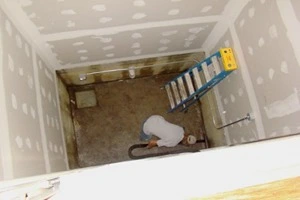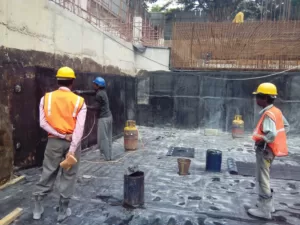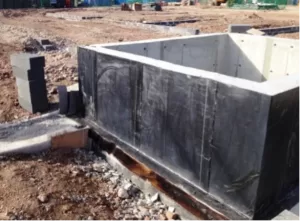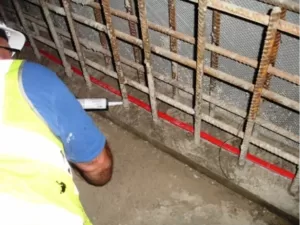

1.Lift Pit Waterproofing (ELEVATOR PIT) – importance
Waterproofing the lift pit or elevator pit in buildings is important for several reasons:
- Prevents water damage: Lift pits are susceptible to water damage from various sources, such as groundwater, rainwater, and plumbing leaks. Waterproofing the lift pit prevents water ingress, which can cause damage to the elevator components, including electrical systems and metal surfaces.
- Avoids corrosion: Water can cause corrosion to elevator components, such as steel support beams and cables, leading to structural instability and safety hazards. Waterproofing the lift pit prevents corrosion and prolongs the lifespan of the elevator system.
- Ensures safety: A compromised elevator system due to water damage or corrosion can pose a safety risk to occupants. By waterproofing the lift pit, building owners can ensure the safety of their tenants and visitors.
- Compliance with regulations: Building codes and regulations require lift pits to be waterproofed to prevent water damage and corrosion. Failure to comply with these regulations can result in penalties and fines.
- Cost-effective solution: Waterproofing the lift pit is a cost-effective solution compared to the cost of repairing or replacing damaged elevator components. It also reduces the risk of unexpected repair or replacement costs.
2. available systems for Lift Pit Waterproofing (ELEVATOR PIT)
There are several systems available for lift pit waterproofing. Here are some of the commonly used systems:
- Cementitious Coatings: This is a traditional and cost-effective waterproofing solution. It involves applying a cement-based coating to the lift pit walls and floor. Cementitious coatings are easy to apply and can provide a durable lift pit waterproofing Solution.
- Liquid-Applied Membranes: This is a more advanced waterproofing system that involves applying a liquid coating to the lift pit walls and floor. Liquid-applied membranes are highly flexible and can accommodate movements in the lift pit structure. They also provide excellent resistance to water, chemicals, and abrasions.
- Sheet Membranes: This system involves installing a waterproof sheet membrane on the lift pit walls and floor. Sheet membranes are highly effective at preventing water ingress and are easy to install. They are also resistant to water, chemicals, and punctures.
- Injection Grouting: This is a technique used to fill cracks and voids in the lift pit structure. Injection grouting involves injecting a waterproof material into the cracks and voids to seal them and prevent water ingress. This system can be used in conjunction with other waterproofing systems.
- Bentonite Waterproofing: This system involves installing a bentonite clay layer on the lift pit walls and floor. Bentonite is a natural clay material that swells in the presence of water, providing an effective barrier against water ingress.
Each of these waterproofing systems has its own advantages and disadvantages, and the best system for a lift pit will depend on various factors, such as the location, construction, and budget. Consulting with a professional waterproofing contractor can help determine the best lift pit waterproofing system.






3. selection of Lift Pit (Elevator Pit) Waterproofing system
The selection of a lift pit waterproofing system will depend on several factors, such as the location of the lift pit, the construction materials used, and the budget. Here are some key factors to consider when selecting a lift pit waterproofing system:
- Waterproofing Performance: The primary function of the waterproofing system is to prevent water ingress and protect elevator components. It is important to select a system that offers a high level of waterproofing performance and durability.
- Compatibility with Construction Materials: The lift pit waterproofing system should be compatible with the construction materials used in the lift pit. For example, some waterproofing systems may not be suitable for use with certain types of concrete or metal structures.
- Ease of Installation: The waterproofing system should be easy to install and should not require significant disruption to building operations or elevator service.
- Maintenance Requirements: The waterproofing system should be easy to maintain and should not require frequent repairs or maintenance.
- Budget: The cost of the waterproofing system will be a key consideration for building owners and managers. It is important to select a system that provides the necessary level of protection within the budget constraints.
Based on these factors, a professional waterproofing contractor can recommend the best lift pit waterproofing system. The contractor will evaluate the lift pit conditions and recommend a solution that meets the building owner’s requirements for performance, durability, ease of installation, maintenance, and cost.
GEOLIZ WATERPROOFERS PVT. LTD.
Waterproofing Products & Services Guide
For details on other waterproofing products & Services
